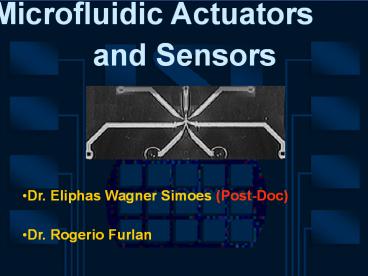Microfluidic devices for gas flow control - PowerPoint PPT Presentation
Title:
Microfluidic devices for gas flow control
Description:
Silicon wet etching - KOH - 27,4 % in water. Plasma etching - HDP plasma SF6 ... Can be operated with some level of suspended solids without clogging ... – PowerPoint PPT presentation
Number of Views:113
Avg rating:3.0/5.0
Title: Microfluidic devices for gas flow control
1
Microfluidic Actuators
and Sensors
- Dr. Eliphas Wagner Simoes (Post-Doc)
- Dr. Rogerio Furlan
2
Microfluidic amplifiers
- No movable part
- Flow control
- Flow mixture
3
Microchannel Technology
- Silicon wet etching - KOH - 27,4 in water
- Plasma etching - HDP plasma SF6
- based - hidraulic diameters of 40 µm
- Anodic bonding - 377C/ 800 V
4
Tests with gas (N2)
5
Flow control results
QS
QC1
QO2
QO1
- Symmetrical behavior
- Non-zero output
6
Flow gain (DQO/DQC) results
- High flow gain up to 8
7
Flow ratio results
- More uniform performance for small splitter angles
8
Analysis of internal flow with Ansys/Flotran
- Choked flow at the output of the supply nozzle
9
Analysis of internal flow with Ansys/Flotran
- Supersonic flow at the interaction region
- Possibility of shock waves formation
10
Analysis of internal flow with Ansys/Flotran
- Laminar to turbulent flow
- Continuum to slip flow
11
Main results for use with gas
- Feasibility for applications that require gas
flow control
- Gain flow comparable to the obtained to devices
with large dimensions
- Possibility of operation with internal
disturbances (shock waves and turbulence) -
application as flow mixer
- Good basis for development of microfluidic
oscillators for flow sensor applications
12
Microfluidic oscilattor
- Flow Measurement
13
Tests with liquids
- Supply flow
- Isopropilic alcohol
- Acetone
- Distilled water
- Control flow
- Nitrogen
- Liquids
14
Supply of liquids with nitrogen control
- Possibility of control for alcohol and acetone
- Influence of viscosity, bubbles and hydrophobic
effects for water
Increasing supply flow
15
Supply of liquids with liquid control
- Possibility of control for alcohol
- Pronounced formation of bubbles for acetone and
water - Flow throughout vents (Coanda Effect?)
Increasing supply flow
16
Rapid prototyping of microfluidic switches in
poly(dimethyl siloxane)and their actuation by
electro-osmotic flow J. Micromech. Microeng. 9
(1999) 211 217 - Department of Chemistry and
Chemical Biology, Harvard University
17
Main results for use with liquids
- Promising results for control with gas
- Strong influence of the type of liquid
(viscosity)
- Possibility of hydrophobic effects - points to
use of other materials and processes
- Can be operated with some level of suspended
solids without clogging































